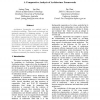Free Online Productivity Tools
i2Speak
i2Symbol
i2OCR
iTex2Img
iWeb2Print
iWeb2Shot
i2Type
iPdf2Split
iPdf2Merge
i2Bopomofo
i2Arabic
i2Style
i2Image
i2PDF
iLatex2Rtf
Sci2ools
APSEC
2004
IEEE
2004
IEEE
A Comparative Analysis of Architecture Frameworks
Architecture frameworks are methods used in architecture modeling. They provide a structured and systematic approach to designing systems. To date there has been little analysis on their roles in system and software engineering and if they are satisfactory. This study provides a model of understanding through analyzing the goals, inputs and outcomes of six Architecture Frameworks. It characterizes two classes of architecture frameworks and identifies some of their deficiencies. To overcome these deficiencies, we propose to use costs, benefits and risks for architecture analysis. We also propose a method to delineate architecture activities from detailed design activities.
APSEC 2004 | Architecture Analysis | Architecture Frameworks | Architecture Modeling | Software Engineering |
| Added | 20 Aug 2010 |
| Updated | 20 Aug 2010 |
| Type | Conference |
| Year | 2004 |
| Where | APSEC |
| Authors | Antony Tang, Jun Han, Pin Chen |
Comments (0)

